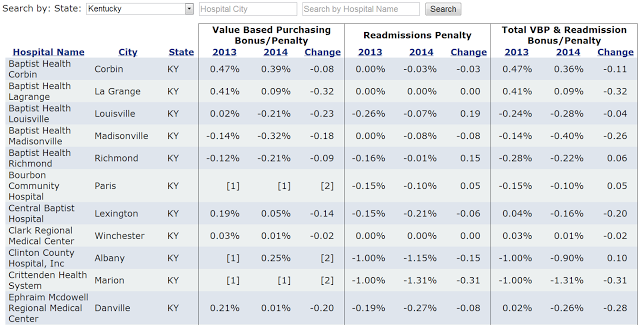Most Kentucky hospitals will pay Medicare penalties under health reform, one the country’s largest; look them up here

Medicare has two quality-care incentive programs for hospitals. Value-based purchasing gives bonuses and penalties based on 24 quality measures, and the other program levies penalties for readmissions. Thirty-one Kentucky hospitals were assessed a penalty while 26 were given a bonus for improved performance, says an analysis by Kaiser Health News. Here’s a screen shot of the beginning of the list:
The law allows the federal government to withhold a portion of a hospital’s Medicare reimbursement money, up to a 1.25 percent penalty or bonus for every bill paid between October 2013 and September 2014, based on assessments of these quality standards.
“The incentives are among the law’s few cost-control provisions that have kicked in, but it is too early to tell how effective they will be in making hospitals operate more efficiently,” reports Kaiser’s Jordan Rau.
Large value-based bonuses are going to some major teaching hospitals and smaller institutions, such as Pikeville Medical Center. The state’s average bonus is 0.25 percent, compared to the national average of 0.24 percent; Kentucky’s penalties averaged minus 0.20 percent, for a total average of zero. It won’t be known how much hospitals will receive or pay in dollar figures until next October since this depends on how much the hospital ends up billing Medicare, Kaiser reports.
However, as a result of the readmission program, Pineville Community Hospital is losing 2.57 percent of its reimbursements,the largest penalty in the country. Considering the impact of both the value-based program and readmissions program, Kaiser reports, two out of three hospitals are losing money starting last month.
Here’s how the value-based score was figured: 45 percent on hospitals’ use of clinical processes of care; 30 percent on patient experiences; and 25 percent on death rates. Hospitals were are also assessed by how they compared to other hospitals and how much they improved from two years ago, says Qualitynet.org.
Researchers are unsure whether the penalties are significant enough to trigger major improvements, writes Rau. And, some hospitals that have made improvements are still losing money because they haven’t improved as much as other hospitals. On the other hand, some hospitals with subpar quality rankings are still getting more money because they showed improvement.
Nationwide, Medicare has raised payment rates to 1,231 hospitals and reduced payments to 1,451. Hospitals that are designated as critical access facilities and certain cancer hospitals were excluded from the program. But these facilities aren’t immune to other portions of the health law, such as cuts in Disproportionate Share Hospital (DSH) program payments,for having a high percentage of Medicare and Medicaid patients.
New quality measures will be added to the value-based program for 2015, including comparisons of how much patients cost Medicare at different hospitals and rates of medical mishaps. In addition, the maximum readmission penalties grow to 3 percent next year, and a third incentive program will take an additional 1 percent of payments away from hospitals that have the most injuries or infections during patients’ stays.
“Combined, these three quality programs have the potential to strip away as much as 5.5 percent of Medicare payments from the worst performing hospitals starting next October,” reports Rau.
Dr. Patrick Conway, Medicare’s chief medical officer, says “We’re moving away from volume and toward quality.” Yet, to remain viable, some hospitals are being forced to make up for payment cuts by seeing more patients. Click here for the interactive chart.

